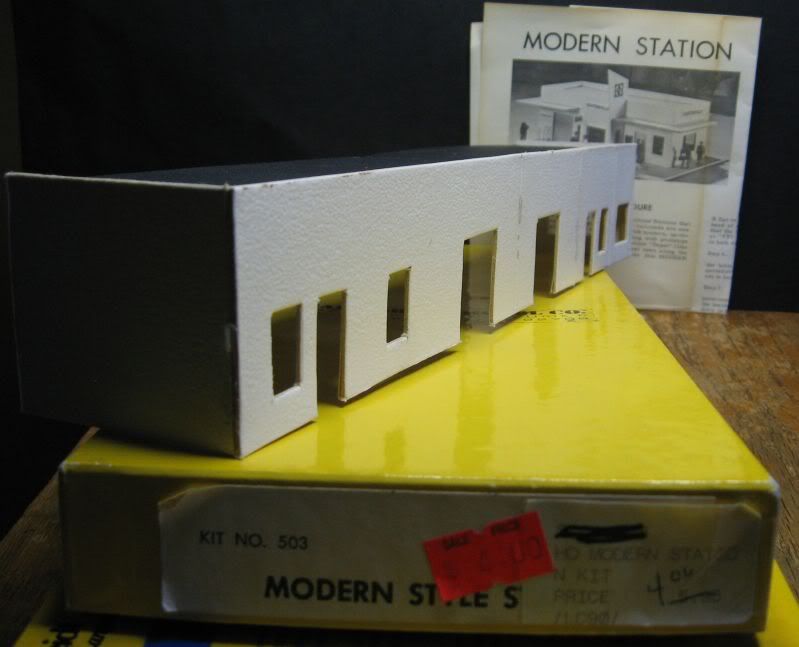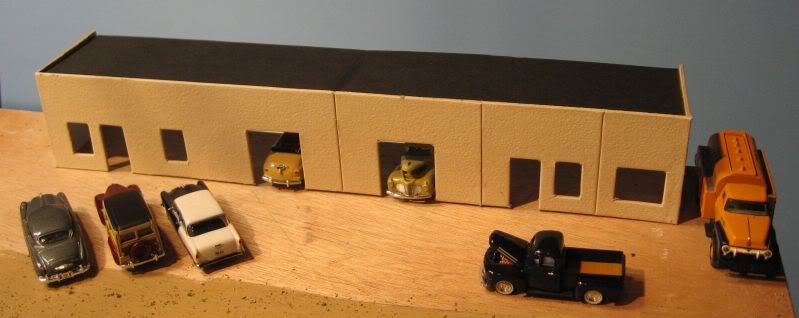This is the kit.
I could see using paper/cardstock buildings to get something quickly on the layout, then go back and spend more time/money for better buildings, one at a time.
While cardstock buildings can be an inexpensive fill-in alternative to buildings using other materials to say other methods are necessairly better is wrong.
Look at the photos of card models posted in this thread and also at the links provided. While some cardstock models are simple and/or crude (also true of models made from other materials), there are many that cannot be matched in quality and detail by your “better” buildings.
It would be, if I had said that.
But I didn’t.
"kevinrr
I could see using paper/cardstock buildings to get something quickly on the layout, then go back and spend more time/money for better buildings, one at a time."
You didn’t say that?
I could see using paper/cardstock buildings to get something quickly on the layout, then go back and spend more time/money for better buildings, one at a time.
If it is the above then two things
One it has not been built as a permanent building in the first place
and two building a permanent building out of card and paper takes time and patience and is just as rugged as any other
It would be done in layers and every layer soaked in shellac or other sealant till the card can’t absorb any more result one very solid structure that won’t warp or twist…
The above assumes a scratch built structure.
regards John
Ok, I haven’t read but about 5 or 6 of the replies, but will just throw in my 2cents. You can make card stock 3D, we’ve done it a lot. The subject line of the post isn’t exactly the same as just placing a picture at the back of the layout. To me, it’s a lot about using various art forms to create a believable scene.
Richard
I think maybe the original complaint was directed towards card stock with printed (photo or drawn) details as opposed to card stock with actual built up detailing. As noted before the advent of plastics many models were made using various forms of card & paper. I know I dulled many exacto and razor blades cutting strathmore and paper.
It all comes down to how well the modeling is done. I’ve seen some pretty awful stuff done in plastic and some spectacular stuff done in card. A flat building done in any material if not positioned properly will look … well like a flat. A poor photo will look artificial no matter where or how it is placed.
Finally I’ve seen stuff like Clever Models and some British card models in person. When well crafted they look very good. Mix in some other materials like strip wood, foils, plaster and/or plastic castings where appropriate, they can look even better.
I use whatever will work for each situation and I try to use new or different techniques and materials to keep the models interesting and to exercise my mind and “stretch” my modeling skills.
Dave
I didn’t intend this when I first posted but this discussion can probably be listed right there with: DC vs. DCC, brass vs. nickel silver track, lone wolf vs. club, cork vs. homasote vs. foam roadbed, free lance vs. prototype.
I have been convinced to at least try some cardstock sturctures so I guess my mission was accomplished. Thanks for all the replies.
And I think most of us who have replied just wanted to raise the awareness that cardstock does not equal cheap, sloppy filler.but is a viable medium in its own right. Not better, just in the mix. Good thread.
While it’s probably true that the average modeler’s use of two-dimensional card models may leave something to be desired in terms of realism, paper models as such should not be dismissed–even for foreground models. British and European modelers make very convincing three dimensional models out of card or paper. For one excellent example, do a Google search on the Danish modeler Troels Kirk’s work for his Maine narrow gauge Coastline Railroad. He uses a water color paper to simulate wood and other construction materials in more accurately scaled proportions than are possible with wood and with better texture than styrene. Here’s a start in discovering what may be an entirely new technique for many:
https://www.facebook.com/pages/The-Coast-Line-RR-page/127409483958090
Frank
The only way to understand a cardstock model is to build one. In no way are our kits strictly 2 dimensional. The beauty and secret is to layer the imaged paper. take a board on board approach by printing two or three kits. Use one as a guide and then use the others to supply material for building dimension. Paper can also be worked by scribing or even embossing a few bricks (you don’t have to do more then 1 in 10 to get a great result) printing brick on watercolor paper gives the flat surface just enough variation to knock out that shine (it embosses well too)
The number one reason to build with card is, it’s fun and satisfying.
We have free kits available for download. try one out.
Thom M
Clever models
Like a lot of people, I had the misconception that “paper” buildings were two-dimensional flats made into a three-dimensional building. But over the weekend, I attended the NMRA Thousand Lakes Region convention, where the guys from Clever Models did a demonstration, showing how to build their buildings (and giving everyone a free kit to work on at home). Their buildings CAN be build ‘flat’ if you want, but they include parts to make the building fully three-dimensional. For example, a ‘simple’ window may have four or five separate pieces, like for an upper and lower sash, so one overhangs the other, and a separate frame that extends outside the building walls. When properly done, it’s really very effective.
As a user of Evans Design Model Builder software, I can speak for the pros and cons of the program.
Pros:
The textures provided are really good, with many options available. (I made an HO warehouse using the software, and it came out looking nice (in my opinion). I’ve attached a picture.)
The program is easy to use, with no prior experience necessary.
The price is nice. $45 is the cost of one plastic building, so the first building you print off pays for the program!
Cons:
The software only runs on Windows (no Mac available ![]() )
)
Some textures and doors are missing, though these may be available in one of the add on software packages.
Hope this helps!
Ben D.


